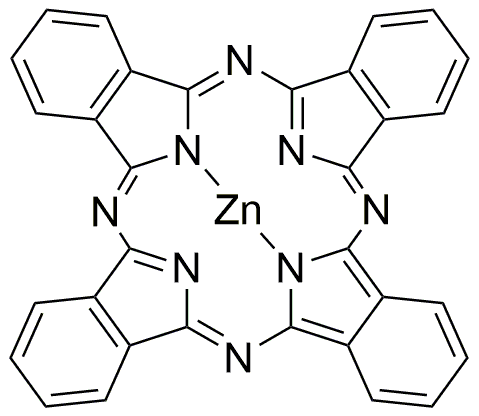Zinc phthalocyanine is widely utilized in research focused on:
- Photodynamic Therapy: This compound is used in medical treatments for cancer, where it helps to generate reactive oxygen species upon light activation, effectively targeting and destroying cancer cells.
- Solar Cells: In the renewable energy sector, it serves as a pigment in organic photovoltaic devices, enhancing light absorption and improving energy conversion efficiency.
- Colorants and Dyes: It is employed in the manufacturing of high-performance dyes and pigments for textiles and plastics, providing vibrant colors with excellent stability and durability.
- Electronics: The compound is used in the production of organic light-emitting diodes (OLEDs), contributing to the development of energy-efficient displays and lighting solutions.
- Environmental Monitoring: Zinc phthalocyanine is utilized in sensors for detecting pollutants, offering a reliable method for monitoring air and water quality.
General Information
Properties
Safety and Regulations
Applications
Zinc phthalocyanine is widely utilized in research focused on:
- Photodynamic Therapy: This compound is used in medical treatments for cancer, where it helps to generate reactive oxygen species upon light activation, effectively targeting and destroying cancer cells.
- Solar Cells: In the renewable energy sector, it serves as a pigment in organic photovoltaic devices, enhancing light absorption and improving energy conversion efficiency.
- Colorants and Dyes: It is employed in the manufacturing of high-performance dyes and pigments for textiles and plastics, providing vibrant colors with excellent stability and durability.
- Electronics: The compound is used in the production of organic light-emitting diodes (OLEDs), contributing to the development of energy-efficient displays and lighting solutions.
- Environmental Monitoring: Zinc phthalocyanine is utilized in sensors for detecting pollutants, offering a reliable method for monitoring air and water quality.
Documents
Safety Data Sheets (SDS)
The SDS provides comprehensive safety information on handling, storage, and disposal of the product.
Product Specification (PS)
The PS provides a comprehensive breakdown of the product’s properties, including chemical composition, physical state, purity, and storage requirements. It also details acceptable quality ranges and the product's intended applications.
Certificates of Analysis (COA)
Search for Certificates of Analysis (COA) by entering the products Lot Number. Lot and Batch Numbers can be found on a product’s label following the words ‘Lot’ or ‘Batch’.
*Catalog Number
*Lot Number
Certificates Of Origin (COO)
This COO confirms the country where the product was manufactured, and also details the materials and components used in it and whether it is derived from natural, synthetic, or other specific sources. This certificate may be required for customs, trade, and regulatory compliance.
*Catalog Number
*Lot Number
Safety Data Sheets (SDS)
The SDS provides comprehensive safety information on handling, storage, and disposal of the product.
DownloadProduct Specification (PS)
The PS provides a comprehensive breakdown of the product’s properties, including chemical composition, physical state, purity, and storage requirements. It also details acceptable quality ranges and the product's intended applications.
DownloadCertificates of Analysis (COA)
Search for Certificates of Analysis (COA) by entering the products Lot Number. Lot and Batch Numbers can be found on a product’s label following the words ‘Lot’ or ‘Batch’.
*Catalog Number
*Lot Number
Certificates Of Origin (COO)
This COO confirms the country where the product was manufactured, and also details the materials and components used in it and whether it is derived from natural, synthetic, or other specific sources. This certificate may be required for customs, trade, and regulatory compliance.


